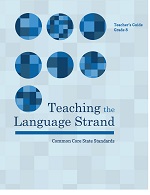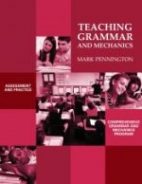How to Teach Complex Sentences
Simply put: Learning to write complex sentences will improve your students’ writing. Perhaps no other revision tool produces a greater “bang for the buck.” However, even the best tools can be overused. A contractor may love her “go-to” nail gun, but sometimes a simple hammer may better fit the task.
Our job as writing teachers is to show developing writers how complex sentences help authors communicate efficiently, precisely, and coherently (three academic language words every student should learn). So often, with our justifiable focus on getting students to write in complete sentences during the primary grades, developing writers get caught in a pit trap of writing simple sentences only in the SUBJECT-PREDICATE-OBJECT pattern. Students need a sturdy ladder to climb out of this trap.
The complex sentence is aptly named. Understanding, recognizing, and producing complex sentences require a substantial amount of prior knowledge and experience in reading, writing, listening, and speaking. We can (and should) use a few short-cuts to get to the end goal of getting students to use complex sentences in their own writing, but we do no service to them by ignoring, simplifying, or generalizing the requisite scaffolds of academic language and syntax. Kids gotta learn how their language works. Yes, that involves plenty of grammar instruction and practice.
To scaffold how to teach complex sentences, teach each rung of the ladder well. Tighten up each of the wobbly rungs and don’t skip any. Your learners are diverse. Who knows what they know and don’t know? (Although you could give my diagnostic grammar and usage assessment to find out).
Connect to and Build Prior Knowledge
RUNG 1
“First, let’s review the characteristics of a simple sentence.”
Write or display these definitions and examples, read them out loud, and tell students to copy them.
“A simple sentence has three characteristics: 1. It tells a complete thought. 2. It has both a subject and a predicate. The subject is a noun or pronoun and serves as the “do-er” of the sentence. A noun is a person, place, thing, or idea. A pronoun takes the place of a noun. The predicate is a verb or verbs and acts upon the subject or links the subject to something else in the sentence. 3. When read out loud, a simple sentence makes the voice drop down at the end of a statement or go up at the end of a question. Examples: Karen enjoys chocolate. Do you like chocolate?
Identify the Problem: Connect to Oral Language and Reading
RUNG 2
Convince students that too many simple sentences strung together can be a problem, especially in essays. Reading out loud helps students identify the machine gun quality of repetitive simple sentences. Write or display this paragraph and read it out loud.
“Now listen to me as I read this paragraph of simple sentences. Afterwards, let’s read the paragraph out loud together as a class.”
Thomas Alva Edison was born into a well-educated family. He had a lot of challenges to overcome. Tom was the youngest of seven children. Tom did not receive undivided attention from his parents. His parent had so many children. Thomas did not learn to talk as a young boy. His parents did not interact much with him. His siblings did not interact much with him. He finally learned to talk. He began talking at age four. Then he would not stop. He asked why and how questions about everything.
Debrief with your students: “What did you think about how this paragraph is written? How did it sound? Each sentence in the paragraph is a simple sentence. We can combine simple sentences with a conjunction to form another type of sentence: the compound sentences. A conjunction is a joining word. When we combine simple sentences, we change the name of a simple sentence to an independent clause. Let’s copy these definitions and example: A simple sentence is an independent clause. Two or more joined independent clauses form a compound sentence. Example: Then he would not stop, and he asked why and how questions about everything.
Another type of sentence is the complex sentence. Let’s listen to me as I read the same paragraph, revised with some revised complex sentences. Afterwards, we will read the paragraph out loud together as a class.”
Identify the Solution: Connect to Oral Language and Reading
RUNG 3
Convince students that adding sentence variety by including complex sentences makes writing more efficient, precise, and coherent. “Now listen to me as I read this paragraph of simple sentences. Afterwards, let’s read the paragraph out loud together as a class.”
Although Thomas Alva Edison was born into a well-educated family, he had a lot of challenges to overcome. Tom was the youngest of seven children. Because his parents had so many children, Tom did not receive their undivided attention. Thomas did not learn to talk as a young boy since his parents and siblings rarely interacted with him. When he finally learned to talk at age four, he would not stop. He asked why and how questions about everything.
Debrief with your students: “Does this revised paragraph provide the same information as the first? What did you think about how this revised paragraph is written? How did it sound? Many of the sentences in this revised paragraph are complex sentences. Let’s copy this down: A complex sentence has one independent clause and at least one dependent clause. A dependent clause has three characteristics: 1. It begins with a subordinate conjunction. Subordinate means less important than or under the control of someone or something else. 2. It has at least one noun or a pronoun and at least one connected verb. 3. When read out loud, a dependent clause does not makes the voice drop down at the end of a statement. Example: Although (subordinate conjunction) Mike (noun) and I (pronoun) listen (verb), (When read out loud the voice does not drop down.)
Now let’s figure out how the author formed complex sentences to make the our own writing efficient, precise, and coherent. Efficient means to be well-organized and not wasteful. Precise means to be specific and exact. Coherent means to be logical, orderly, and consistent.”
Teach How to Write Dependent Clauses
RUNG 4
“Write down this formula for writing dependent clauses: dependent clause = subordinate conjunction (Bud is wise, but hot! AAA WWW) + at least noun or pronoun + at least one connected verb + any other words.
Bud is wise, but hot! AAA WWW is a memory trick to help you remember the common subordinate conjunctions. Copy down this list, underlining the first letter of each subordinate conjunction:”
before, unless, despite (in spite of), in order that, so, while, if, since, even though (if), because, until, that, how, once, than, after, although (though), as (as if, as long as, as though), whether, when (whenever), where (wherever)
Have students write and share five dependent clauses in their notebooks and pair share as you monitor this guided practice.
Teach How to Connect Dependent Clauses to Independent Clauses
RUNG 5
“A dependent clause added onto an independent clause (a simple sentence) forms a complex sentence. The dependent clause may be placed at the beginning, in the middle, or at the end of a sentence. Copy these sentences with their examples.
Place a comma after a dependent clause that begins a sentence. Example: After I sneeze, I always blow my nose.
Place commas before and after a dependent clause in the middle of the sentence. Example: I use a handkerchief, when I sneeze, to be polite.
Don’t place a comma before a dependent clause that ends a sentence. Example: I stop sneezing when it’s not allergy season.”
Assign a Formative Assessment to Determine Mastery
RUNG 6
Write a short paragraph in which you use three complex sentences: one at the beginning of a sentence; one in the middle of a sentence; and one at the end of a sentence.
Extend the Learning: Writing Style
RUNG 7
A little knowledge can be a dangerous thing. Teach students to avoid using more than two complex sentences in a row in any given paragraph. Overuse of simple sentences is problematic, but the same is true with complex sentences. Review the revised paragraph above and analyze the different types of sentences, their placements within the paragraph, and the placement of the dependent clause within the complex sentences themselves. Analyze the types of sentences in both narrative and expository text.
*****

Pennington Publishing Grammar Programs
Teaching Grammar, Usage, and Mechanics (Grades 4, 5, 6, 7, 8, and High School) are full-year, traditional, grade-level grammar, usage, and mechanics programs with plenty of remedial practice to help students catch up while they keep up with grade-level standards. Twice-per-week, 30-minute, no prep lessons in print or interactive Google slides with a fun secret agent theme. Simple sentence diagrams, mentor texts, video lessons, sentence dictations. Plenty of practice in the writing context. Includes biweekly tests and a final exam.
Grammar, Usage, and Mechanics Interactive Notebook (Grades 4‒8) is a full-year, no prep interactive notebook without all the mess. Twice-per-week, 30-minute, no prep grammar, usage, and mechanics lessons, formatted in Cornell Notes with cartoon response, writing application, 3D graphic organizers (easy cut and paste foldables), and great resource links. No need to create a teacher INB for student make-up work—it’s done for you! Plus, get remedial worksheets, biweekly tests, and a final exam.
Syntax in Reading and Writing is a function-based, sentence level syntax program, designed to build reading comprehension and increase writing sophistication. The 18 parts of speech, phrases, and clauses lessons are each leveled from basic (elementary) to advanced (middle and high school) and feature 5 lesson components (10–15 minutes each): 1. Learn It! 2. Identify It! 3. Explain It! (analysis of challenging sentences) 4. Revise It! (kernel sentences, sentence expansion, syntactic manipulation) 5. Create It! (Short writing application with the syntactic focus in different genre).
Get the Diagnostic Grammar, Usage, and Mechanics Assessments, Matrix, and Final Exam FREE Resource:
![]()





